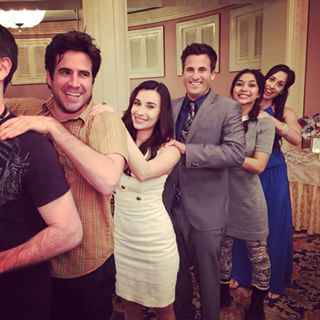"We make a living by what we get. We make a life by what we give." -- Winston Churchill
In most cases, 12 people rubbing each other in public is considered illegal. But, there is one loophole: massage trains.
Massage trains are the perfect "giving organization." They involve a line of people each massaging the neck, back, or shoulders of the person in front of them. By creating a "pay-it-forward" norm, they train members to help everyone else. Massage trains can teach us a lot about the psychology of groups. In particular, they show us how to create a giving culture.
How to Start a Massage Train
Logistically, massage trains are simple. Line up three or more people. Then turn them 90 degrees. Your train is ready.
Physically, massage trains are great. Massage helps us relax, reduce muscle pain, and sleep better. But in reality, massage trains are rare. Close friends seldom massage each other, much less form a line. Sadly, we've relegated massage trains to summer camp and strangely intimate soccer moms.
But, why? If massage trains are so great, why are we so bad at starting them? Why are giving organizations so hard to create?
With this thought in mind, I made it my summer goal to start as many massage trains as possible. Unfortunately, my initial experiments were less than successful. As I learned, talking loudly about my sore shoulders did little. Simply shouting, "Let's start a massage train!" drove little action. And strangers, for whatever reason, rarely appreciated a friendly shoulder rub.
Two months in and I hadn't started a single massage train.
Then, late in the summer, I stumbled upon a solution. Tired from a day of walking, I looked around at my friends rubbing their own shoulders. Generally, I would have asked the question, "Who wants to join a massage train?" But, tired of rejection, I decided to change the offer.
"Who wants a massage?"
Instantly, people volunteered. Women threw themselves at me, like I assume they do Ryan Gosling or coconut hand wash. As I massaged the first person, a beautiful thing happened: she offered to massage someone else. Soon, one more jumped in front of her, and then another. Within minutes, we had 15 people rubbing shoulders: a perfect massage train.
The Psychology of a Giving Culture
So, why did it happen? Why, in that moment, did we start a massage train, while other attempts had failed? After reading Wharton psychologist Adam Grant's Give and Take, the reason became clear. Massage trains embodied the psychology of "giving" organizations.
Giving organizations reflect the "pay-it-forward" norm. Instead of a net-zero culture, where members demand reciprocity, each person gives and receives freely. A culture of generosity is key to any group. A meta-analysis showed that teams with higher levels of giving are more productive, profitable, and better places to work.
So, how can you start a giving organization? Some key lessons lay in our massage train.
How to Create a Giving Culture: 5 Lessons from a Massage Train
1. Give First
How can you create a giving culture? Give first. By offering to massage another person, you impose a small sacrifice on yourself. But, you also create the opportunity for that person to massage his/her friend.
You can't create a "giving organization" by announcement. Instead, you should model behavior for others to follow. It's almost impossible to start a massage train by simply saying "Let's start a massage train." But, if you give another person a massage, they'll feel inspired to help someone else out. Giving organizations work similarly. Offer help first. In doing so, you'll become a model for others.
2. Start with the Right People
When you begin your massage train, the first person you choose is key. If you select a generous friend, he/she will often massage someone else. But, if you massage someone who's more self-interested, he/she might not, ending the potential train.
Giving organizations select members carefully. They look for qualities like generosity, sacrifice, and compassion. To find out who's a giver, ask for references from their peers and subordinates. Most people present a helpful self to their bosses. But, how they interact with those of equal or lesser status predicts their behavior better.
3. Make it Easy to Enter the Giving Cycle
You can enter a massage train in one of two ways: you could join the front, so that you receive but don't give a massage, or you could begin at the back, so you give but do not receive. So, which is better? And does it matter?
Your goal should be to help everyone enter the train. So, make it clear that everyone has to receive first (i.e. join the front). This helps more self-interested individuals enter the train. It also gives more other-interested individuals an excuse to receive. Once someone has entered the train the expectation is that they will pay it forward (by massaging someone else). Organizations work similarly. Make sure that new members receive help early on. From there, they'll understand that giving is a group norm.
4. Create an Expectation of Paying It Forward
For many groups, the expectation is "if I help you out, you'll help me out." This tit-for-tat system, unfortunately, makes it difficult to ask for or receive help. A better system focuses on paying it forward. We can see this mentality in a massage circle. If individuals wanted to "pay it back", then we could only have two people massaging each other. The beauty of the train is that people are unable to help those behind them. Instead, they have to extend the giving by massaging someone else.
Structure your organization like a massage train. If, at any time, you help someone, reenforce that you want them to pay it forward by helping someone else. In doing so, you'll foster giving and reduce a feeling of obligation around receiving.
5. Make Giving Public
In Give and Take: A Revolutionary Guide To Success, Adam Grant describes an activity to promote giving called "The Reciprocity Ring." The Reciprocity Ring involves a group of people making requests for help to the group. Requests can involve looking for an internship, a personal request, or a life time goal. Individuals in the group can then step-up and say how they could help out.
The Reciprocity Ring strongly promotes giving. Because the giving is public, you have to say aloud how you'll help, it compels both "givers" and "takers" to give. In a massage train, it would be impossible to only receive. If you did, it would be immediately clear to the rest of the group. Instead, because giving (i.e. massaging) is public, it helps other people join the train.
"Giving organizations" are more productive, more creative, and better places to work. So, even if you don't want a shoulder rub, listen up. Apply these lessons and you'll fundamentally change the culture around you.
In a world of short-term trading, "me culture", and small bickering, it seems like a massage train is sorely needed.

